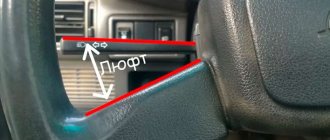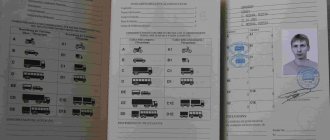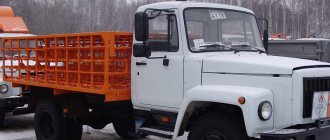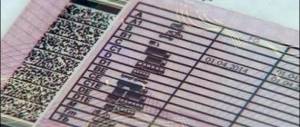/ Traffic regulations / Vehicle approval / Malfunctions
Traffic regulations SignsMarking Vehicle approval
Appendix to the Basic Provisions for the admission of vehicles to operation and the responsibilities of officials to ensure road safety
With the latest changes dated March 24, 2017, coming into force on April 4, 2021 (RF Government Decree No. 333 dated March 24, 2017).
Paragraph:
This List establishes malfunctions of cars, buses, road trains, trailers, motorcycles, mopeds, tractors, and other self-propelled vehicles and the conditions under which their operation is prohibited. Methods for checking the given parameters are regulated by GOST R 51709-2001 “Motor vehicles. Safety requirements for technical condition and verification methods."
Brake systems
1.1. The standards for braking efficiency of the service brake system do not comply with GOST R 51709-2001.
1.2. The seal of the hydraulic brake drive is broken.
1.3. Violation of the tightness of the pneumatic and pneumohydraulic brake drives causes a drop in air pressure when the engine is not running by 0.05 MPa or more within 15 minutes after they are fully activated. Leakage of compressed air from wheel brake chambers.
1.4. The pressure gauge of the pneumatic or pneumohydraulic brake drives does not work.
1.5. The parking brake system does not ensure a stationary state:
- vehicles with a full load - on a slope of up to 16 percent inclusive;
- passenger cars and buses in running order - on a slope of up to 23 percent inclusive;
- trucks and road trains in equipped condition - on a slope of up to 31 percent inclusive.
Engine
6.1. The content of harmful substances in the exhaust gases and their opacity exceed the values established by GOST R 52033-2003 and GOST R 52160-2003.
6.2. The tightness of the power supply system is broken.
6.3. The exhaust system is faulty.
6.4. The seal of the crankcase ventilation system is broken.
6.5. The permissible level of external noise exceeds the values established by GOST R 52231-2004.
Steering
2.1. The total play in the steering exceeds the following values:
| Vehicle | Backlash |
| Passenger cars and trucks and buses based on them | 10 |
| Buses | 20 |
| Trucks | 25 |
where, Backlash - Total backlash no more than (degrees).
2.2. There are movements of parts and assemblies not provided for by the design. Threaded connections are not tightened or secured in the correct manner. The steering column position locking device is inoperative.
2.3. The power steering or steering damper provided by the design is faulty or missing (for motorcycles).
External lighting devices
3.1. The number, type, color, location and operating mode of external lighting devices do not meet the requirements of the vehicle design.
Note. On discontinued vehicles, it is permitted to install external lighting devices from vehicles of other makes and models.
3.2. Headlight adjustment does not comply with GOST R 51709-2001.
3.3. External lighting devices and reflectors do not work in the prescribed mode or are dirty.
3.4. Light fixtures do not have lenses or use lenses and lamps that do not match the type of light fixture.
3.5. The installation of flashing beacons, the methods of their fastening and the visibility of the light signal do not meet the established requirements.
3.6. The vehicle is equipped with:
- in front - lighting devices with lights of any color other than white, yellow or orange, and retroreflective devices of any color other than white;
- at the rear - reverse lights and state registration plate lights with lights of any color other than white, and other lighting devices with lights of any color other than red, yellow or orange, as well as retroreflective devices of any color other than red.
Note. The provisions of this paragraph do not apply to state registration, distinctive and identification marks installed on vehicles.
What problems should you not drive with?
A vehicle is a complex multi-component system with a large number of technological units that must operate in optimal mode. But there is a list of malfunctions in which the operation of the vehicle is prohibited, since this threatens the safety of people in the car and others. This list is regulated by GOST R 51709-2001. Additionally, this list is indicated in paragraph 2.3.1 of section 2 of the traffic rules. If such a breakdown occurs, the owner or driver of the car:
If the breakdown was repaired on site, movement can continue without any restrictions. If it is impossible to repair on site, but while maintaining the ability to move, you can proceed to the repair site or parking lot, subject to precautions. The Traffic Regulations have a separate Appendix that discusses this list in detail.
Wheels and tires
5.1. The remaining tire tread depth (in the absence of wear indicators) is no more than:
- for vehicles of categories L - 0.8 mm;
- for vehicles of categories N2, N3, O3, O4 - 1 mm;
- for vehicles of categories M1, N1, O1, O2 - 1.6 mm;
- for vehicles of categories M2, M3 - 2 mm.
The remaining tread depth of winter tires intended for use on icy or snowy road surfaces, marked with a sign in the form of a mountain peak with three peaks and a snowflake inside it, as well as marked with the signs “M+S”, “M&S”, “MS” (if absence of wear indicators), during operation on the specified coating is no more than 4 mm.
Note. The designation of the vehicle category in this paragraph is established in accordance with Appendix No. 1 to the technical regulations of the Customs Union “On the safety of wheeled vehicles”, adopted by decision of the Customs Union Commission dated December 9, 2011 No. 877.
5.2. Tires have external damage (punctures, cuts, breaks), exposing the cord, as well as delamination of the carcass, peeling of the tread and sidewall.
5.3. The fastening bolt (nut) is missing or there are cracks in the disk and wheel rims, there are visible irregularities in the shape and size of the mounting holes.
5.4. The tires are not the correct size or load capacity for the vehicle model.
5.5. One axle of the vehicle is equipped with tires of various sizes, designs (radial, diagonal, tubed, tubeless), models, with different tread patterns, frost-resistant and non-frost-resistant, new and reconditioned, new and with an in-depth tread pattern. The vehicle is equipped with studded and non-studded tires.
Other vehicle design elements
The largest number of malfunctions that prevent the vehicle from being used relate to components that are not part of the vehicle systems listed above.
However, you need to know them, since here we are talking not so much about violations punishable by a fine, but about the safety of both the driver himself and other participants in the traffic accident:
- The number of rear-view mirrors or their location does not meet the requirements of GOSTR 051709-2001. The vehicle does not have windows that are an integral part of the vehicle’s design (side, front, rear). If we are talking about a road train with several trailers, then the tractor cab on the right must be equipped with additional mirrors that allow you to see the road in the area where the rear axle of the furthest trailer is located when the vehicle is turned at an angle of 90º with an outer overall radius of 12 meters. The instructor's seat in the training vehicle must be equipped with an additional glazing mirror. The use of mirrors that provide greater visibility to the rear than standard mirrors is not prohibited.
- The sound signal does not function. The design of the vehicle does not meet the automaker's specifications. The sound of the signal must be monotonous; it is prohibited to use a horn that sounds like a siren.
- On the windows, front/rear parts of vehicles, coatings are applied in front of the windows, or objects are mounted that impair visibility. Acceptable visibility parameters for speakers on the driver's side are regulated by GOST 028070-89. This prohibition does not apply to transparent sun-protection films installed on the top of the glass. Tinting of glass is allowed if their light transmission corresponds to the values prescribed in GOST 05727-88. It is allowed to use curtains on the side windows (buses only), rear curtains on passenger cars and buses if there are side mirrors on both sides of the cab. Light transmission indicators should be as follows: for the windshield - at least 75%, front windows - at least 70%, rear windows (including side windows) - 60%. The use of mirror tinting is prohibited, since such films pose a danger to other vehicles, blinding them with reflected light. The width of the upper sun protection strip should not exceed 14 cm. Curtains/blinds can only be installed in accordance with the attached instructions. Note that many passive safety standards, the main goal of which is to reduce the severity of road accidents, are included in both Russian and international traffic safety standards.
- Door locks, locking mechanisms for the sides or necks of tanks, mechanisms for closing the fuel tank neck, a mechanism for adjusting the angles of the driver's seat, a vehicle speedometer/tachograph, a bus stop signal, window heating/blowing mechanisms, lighting are not working or are installed inappropriately for the vehicle design. interior and emergency exits in buses, door opening/closing mechanisms, anti-theft devices. Let's take a closer look at these faults:
- All door locks must be positioned to close completely. Their design should not allow for accidental opening.
- The locks securing the sides must be extremely reliable and prevent spontaneous opening as a result of shaking.
- The necks of tanks must be clean and free of traces of corrosion, as well as mechanical damage that impairs their tightness.
- Fuel leakage through the neck of the gas tank is not allowed even when the vehicle rolls over (leakage is allowed in minimal volumes).
- The driver's seat adjustment device must contain mechanisms that ensure reliable locking in specified positions and are activated automatically.
- Emergency doors on buses must be equipped with devices that allow them to be opened both from the inside and from the outside. Emergency glass must have a mechanism for opening from the inside/outside or have a device for quick dismantling or breaking; the glass itself must be safe. The same requirements apply to emergency hatches (opening from the inside and outside). Emergency exits must contain signs with appropriate inscriptions. It is prohibited to place structural elements on the bus that restrict access to all of the above emergency means of evacuation (doors, windows, hatches).
- All buses with a capacity of more than 20 seats, as well as trucks weighing more than 15 tons, engaged in international/international transport must be equipped with a tachograph.
- All existing types of anti-theft equipment (individual door locking, steering wheel or ignition lock) must be in working order.
- Glass blowing/heating devices in accordance with GOST 025478-91 must be in good working order and provide quick and effective removal of fogging.
- The vehicle does not have standard mudguards and aprons, as well as protective devices that protect passenger cars from collisions with a truck in front weighing over 3.5 tons (if such devices are not provided for by the design of the truck). If the presence of mudguards and aprons is not provided for by the design of the car, they should be installed independently.
- The tractor's coupling mechanism does not work, safety cables are missing or not functioning. It is not allowed to operate motorcycles that have play in the connecting mechanism of the frame with the side trailer. Checking for play is done by rocking the motorcycle.
- The vehicle is not equipped with a warning triangle and a first aid kit; buses and trucks weighing more than 3.5 tons are not equipped with wheel chocks. The composition of the first aid kit is regulated by the Order of the Ministry of Health of the Russian Federation, the latest amendments to which were adopted in 2009. It is not allowed to independently replace or complete the first aid kit, or store expired or damaged packaging products and medications. After using one of the products, the first aid kit should be restocked. The requirements for the warning triangle are regulated by GOST 024333-97, the requirements of which are brought into compliance with the UNECE rules (clause 27). The first aid kit and fire extinguishing agent must be stored in places provided for by the design features of the vehicle. It is not allowed to store fire extinguishers that do not have a seal or that are expired. Buses or trucks intended for transporting people must have two fire extinguishers, one in the passenger compartment and one for the driver.
- It is prohibited to illegally equip a vehicle with special signals (flashing beacons or sound signals), as well as to have special inscriptions and color schemes on the vehicle that do not comply with the state standards of the Russian Federation. When repainting a vehicle, it is prohibited to use special color schemes intended for specific categories of transport in accordance with GOSTR 050574-93, as well as to install special sound/light signals without permission from the competent authorities.
- There are no head restraints and seat belts, if their presence is provided for by the vehicle design.
- The seat belts are damaged or do not work (they do not lock, the straps are torn, the tension mechanism is not working). After an accident, the seat belts that were in use at the time of the accident must be replaced.
- If the vehicle design provides for the use of a mechanism for lifting the spare wheel (for example, a winch), its operation is prohibited if the mechanism is faulty, or if the spare wheel holder does not ensure its retention, or when the winch ratchet is not able to fix the drum with a cable or rope.
- If the semi-trailer is not equipped with a support device, or it is faulty (the lifting mechanism or support clamps do not work).
- There are defects in the seals, or the tightness of the connections of components and assemblies of the engine, transmission, gearboxes, clutch, battery, rear axle, additional hydraulic devices, as well as the vehicle’s air conditioning system is broken.
- The cylinder parameters indicated on the cylinder labels of buses and cars equipped with gas equipment do not correspond to the technical data sheet of the equipment; there are no dates for the gas equipment inspection.
- The registration number of the vehicle or the method of its fastening does not comply with GOSTR 050577-93.
- The motorcycle is not equipped with the safety bars required by its design. This requirement is contained in OST 037.004.008-78, and is also described in the motorcycle manufacturer’s instructions. The mandatory presence of roll bars applies to motorcycles whose dry weight (excluding the weight of technical fluids and equipment) exceeds 0.15 tons. On lighter motor vehicles, the presence of roll bars is not a mandatory condition. When a motorcycle falls, roll bars protect the driver’s legs from injury, and this technical device must withstand force loads five times greater than the curb weight of the motor vehicle.
- Motorcycles, scooters, and mopeds do not have footrests or cross handles located on the saddle intended for passengers (if the design of the motorcycle provides space for carrying passengers). The cross handle should not be rigid, providing a comfortable grip for the passenger. The absence of a saddle handle is allowed if the design of the motorcycle provides for another method of holding a passenger (for example, U-shaped handles mounted on the rear fender on both sides opposite the rear seat).
- The design of the vehicle contains modifications that were made without permission from the State Traffic Safety Inspectorate of the Ministry of Internal Affairs of the Russian Federation or other authorized bodies.
#Exterior lights#Engine#Steering#Windshield wipers/washers#Brake system










